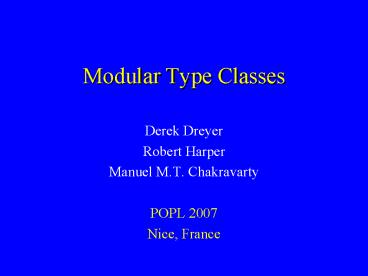Modular Type Classes - PowerPoint PPT Presentation
Title:
Modular Type Classes
Description:
Can hook into the type inference engine and make use of Haskell-style overloading, if ... Basic idea: Add type components to classes. Falls out naturally from modular framework ... – PowerPoint PPT presentation
Number of Views:46
Avg rating:3.0/5.0
Title: Modular Type Classes
1
Modular Type Classes
- Derek Dreyer
- Robert Harper
- Manuel M.T. Chakravarty
- POPL 2007
- Nice, France
2
Specifications
- Haskell
3
Specifications
- Haskell
ML
4
Implementations
- Haskell
5
Implementations
- Haskell
ML
6
Generic Implementations
- Haskell
7
Generic Implementations
- Haskell
ML
8
Type Classes vs. Modules
- Haskell type classes (Wadler and Blott, Jones, et
al.) - Elegant account of ad-hoc polymorphism
- May want different instances of integer equality
to be canonical in different scopes - Not a substitute for a module system
- ML modules (MacQueen, Harper, Leroy, et al.)
- Explicit, fine-grained control over linking and
abstraction - No support for implicit program construction
9
Our Proposal
- Start with ML modules
- Classes are just signatures of a special form
- Instances are just structures and functors of a
special form - Allow programmers to designate certain instance
modules as canonical within a particular scope - No tradeoff necessary Get the best of both
worlds! - Have access to full-featured module system by
default - Can hook into the type inference engine and make
use of Haskell-style overloading, if/when you
want to
10
Classes and Instances in ML
- Great, but now how do we create the eq function?
11
Creating an Overloaded Function
- We employ an overload mechanism
- This creates a polymorphic value eq,
represented internally (in the semantics) as an
implicit functor - Analogous to Haskells qualified types
12
Using eq
- If we apply eq to some arguments of type int
int - This initiates a demand for a canonical module of
signature - But none exists ) Type error!
13
Making an Instance Canonical
- Designate EqInt and EqProd as canonical in a
certain scope
14
Making an Instance Canonical
- Now if we apply eq in that scope
- Then the above code typechecks and translates
internally to - Similar to evidence translation in Haskell
- Here we use modules as evidence
15
Class Hierarchies
- Haskell subclass declaration
How to support class hierarchies using modules?
16
Class Hierarchies
- Haskell subclass declaration
- How to support class hierarchies using modules?
- Use module hierarchies!
17
Composite Class Signatures
- Instances of ORD are automatically computed
frominstances of EQ and instances of LT
18
Associated Types
- Proposed by Chakravarty et al. (2005) as an
alternative tofunctional dependencies - Basic idea Add type components to classes
- Falls out naturally from modular framework
- Associated types are just type components of
class signatures other than the one called t - In Haskell, requires the introduction of
equality constraints - In ML, these are just where type constraints
19
What Else is in the Paper
- Other design points
- Coercions between implicit and explicit functors
- Coherence in the presence of explicitly-scoped
instances - Handling of overlapping instances
- Type-theoretic formalization (details in the tech
report) - Declarative elaboration semantics (a la
Harper-Stone) - Type inference algorithm
- Algorithm is sound, but not complete(due to
problems inherited from both Haskell and ML) - Related work
20
Thank You!
21
Extra Slides
22
Associated Types(Chakravarty et al. 05)
- A function sumColl that sums the elements of a
collectionwould have polymorphic type
23
Haskell Approach
- Beef up type classes
- Multi-parameter classes (Jones, Peyton Jones, et
al.) - Constructor classes (Jones 95)
- Functional dependencies (Jones 00)
- Associated types (Chakravarty et al. 05)
- and more
- Each extension brings classes closer to
modules,but still no explicit control over
linking - Only attempt at explicit control isnamed
instances (Kahl and Scheffczyk 01)
24
Instance of Ord at Int
- Haskell
25
Instance of Ord at Int
- Haskell
ML
26
Instance of Ord at
- Haskell
27
Instance of Ord at
- Haskell
ML
28
Instance of Ord at
- Haskell
ML
29
Computing a Composite Instance
- Assuming LtInt and LtProd have been used, the
canonical module of signature - is
30
Another Example































